The later Byzantine churches of Nicomedia are mainly from the 9th to the 19th century. Let’s see what we can find, which is primarily based on oral and literary history. In 1888, the ancient city of Nicomedia became Izmit. In this section, we will research some of the later churches found on our list.
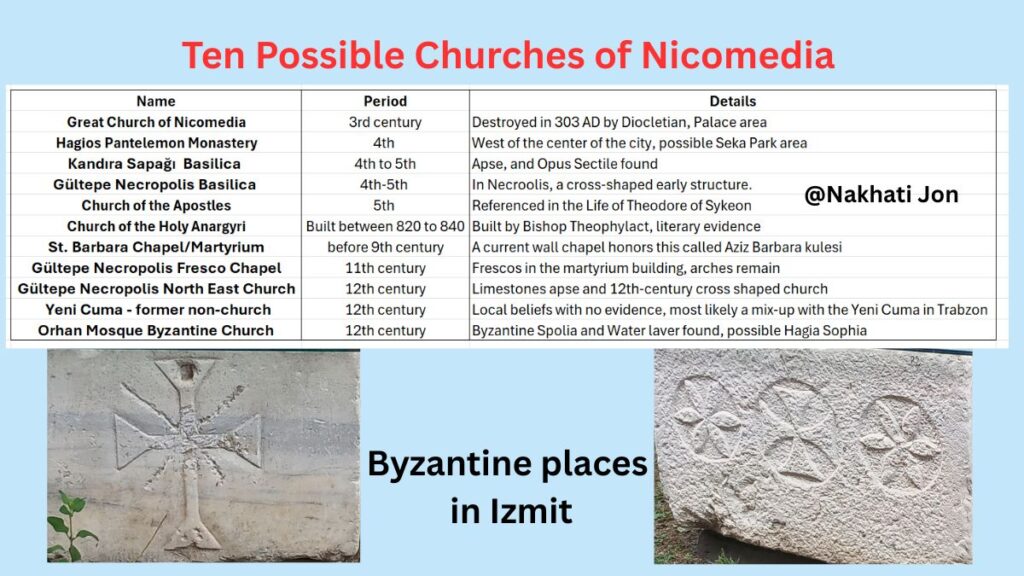
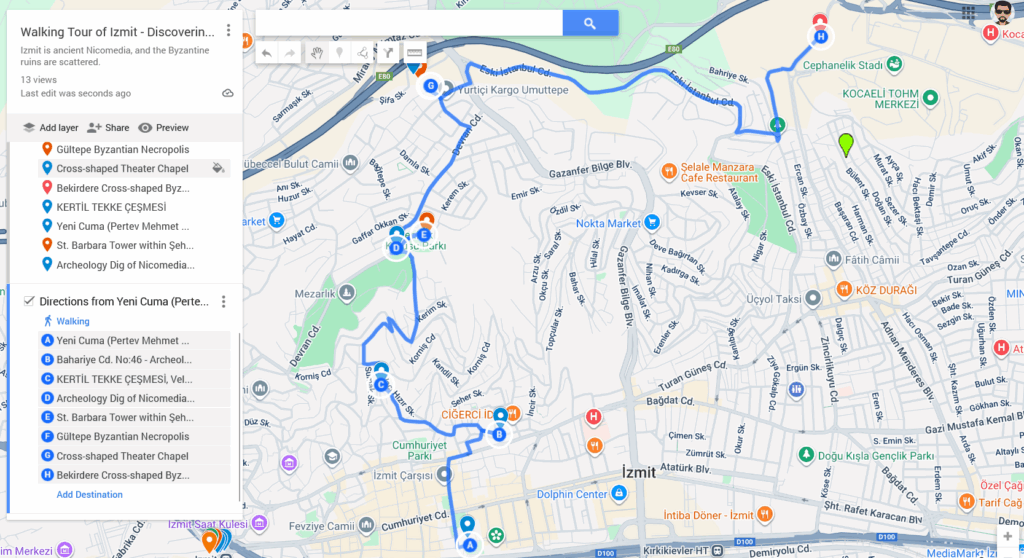
Church of the Holy Anargyri
Church history states that Bishop Theophylact of Nicomedia (bishop from 815 to 842) commissioned the church of the Holy Anarguri to be built in 820 and finished in 840.[1]Life of St. Theophylact, 8 [BHG 2451; VOG, 75] The church or martyrium was named after “Unmercenary saints.” The Greek: Ἅγιοι Ἀνάργυροι, Hagioi Anargyroi, refers to saints who were physicians or healers who offered medical care without accepting payment. The Greek word ἀνάργυρος means “without silver or without money” (from a- “without” + argyros “silver, money”.[2]Greek name of the church: Ἅγιοι Ἀνάργυροι — Κοσμᾶς καὶ Δαμιανός“
Greek history states that Saint Theophylact’s relics were placed in the Church of the Holy Anargyroi (Saints Cosmas and Damian) in Nicomedia, which he built. Also, oral Greek history affirms this name of the church. Other Greek churches listed Τάξιαρχοι (Taxiarchai / Archangels Michael & Gabriel) — appear in local parish lists from the late 19th century as well as Ἅγιος Ἰωάννης ὁ Πρόδρομος (St John the Forerunner / St John the Baptist),but these are not in my Byzantine churches.[3]https://ikee.lib.auth.gr/record/124508/files/GRI-2010-5760.pdf The next blog will mention these multiple Greek churches from the past centuries.
St. Barbara Chapel
St. Barbara died a martyr around 303. She was the daughter of the pagan politician named Dioscorus. Her father confined her in a tower when he found out she had become a Christian. She refused marriage and expressed her faith in numerous public ways. After some time, her father’s frustration with her faith became a point of tension, so he handed her over to the authorities. After she endured torture and public humiliation, her own father beheaded her outside of Nicomedia. Immediately afterward, he was struck by lightning, seen as divine punishment.
Near the upper northern walls, but on the south side of the highway, are remains of the Nicomedia tower that bears her name. Possibly this was where St. Barbara was detained, or even beheaded, since she was martyred outside of the city, which in the early 4th century, this area would have been outside of the central area. The location is associated with her in some way, but most likely not her Church or martyrium. This location, called “Azize Barbara Kulesi,” is situated in the appropriately named park – Şehitlik Korusu Park, which means the martyrs’ park.
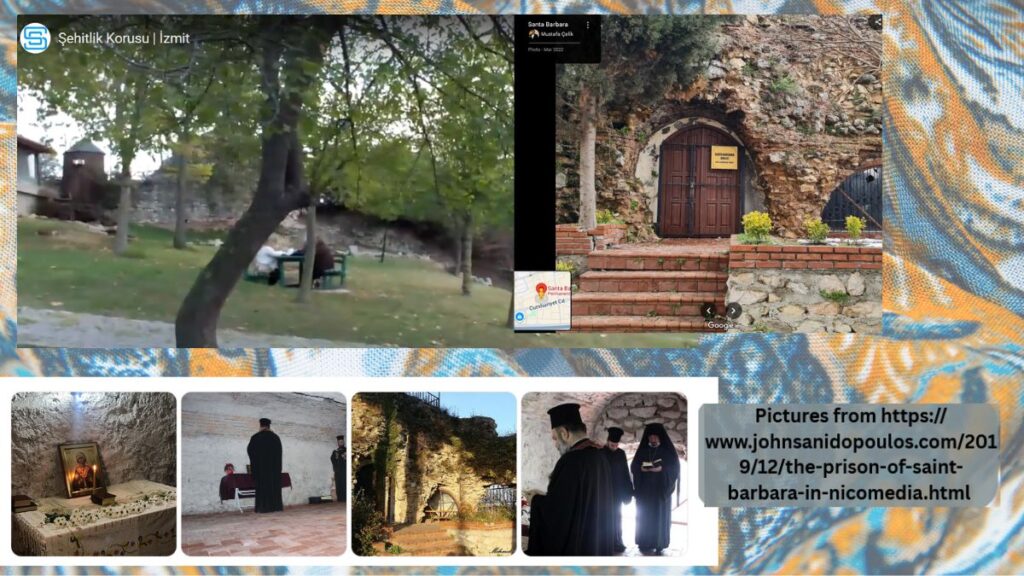
Some Greeks attest to a later church built in the city to honor her, which this website shows a chapel within the remaining walls[4]https://www.johnsanidopoulos.com/2019/12/the-prison-of-saint-barbara-in-nicomedia.html?utm_source=chatgpt.com. This was a commemorative service to honor her memory so this does not prove that a church was at that location. The tower and the written traditions point to her life in ancient Nicomedia. The substantial local, cultural and religious evidence remains quite strong that the Byzantines honored St. Barbara and within the Greek calendar, they remember her on December 4th.
Necropolis Fresco Chapel – 11th Century
In the Necropolis location two churches and a martyrium have been found: “Fresco paintings with nature and animal themes have been identified within the Byzantine tombs in this area. A large 11th-century church and outbuildings, likely religious schools and lodgings, were also unearthed in the same area. The foundations of a small, cruciform church were also unearthed on the eastern edge of the same area.”[5]Yenidoğan-Gültepe Nekropolü Arkeolojik Sit Alanı – Kocaeli – İstanbul ıı nolu K.T.V..K.K. nun 05.07.1994 tarih ve 3507 sayılı kararı[6]Turkish original: Bu alandaki Bizans Mezarları İçinde fresko tekniğinderesimlenmiş doğa ve hayvan temalı resimler tespit edilmiştir.Aynı alanda ortaya çıkarılan 11.yy büyük bir kilise … Continue reading
The ceramic portions and the fresco type show an 11th-century feature. Window lintels and cross panels have been found here. In the fresco area, no graves existed, but the location served as a gathering area for remembrances and worship. In the 1991 dig, up to 15 rooms were explored and some had archway doorways with one room blocked by a marble door. Some of the tombs discovered had marble tops covering the sarcophagi.
The researchers believe the above structure of these large areas had wooden structures which fell or deteriorated since many nails and beams were found on the site. With the multiple earthquakes and conquering many of the graves were broken into naturally or by human theft.
Northeast Necropolis Basilica
This location had two churches (Necropolis Basilica), of which I have only counted one of, since nothing is written about the other. This second church lies north east of the burial area and has limestone block apse construction and a cross-shaped structure.[7]http://www.kulturvarliklari.gov.tr/sempozyum_pdf/muze_kurtarma/04.muze.kurtarma.pdf, 359 I will name this the Northeast Necropolis Cross-shaped Basilica. The area featured a school and lodging, creating a monastery-like setting near the graves of many martyrs. Based on map locations and write-ups, it appears that Byzantine ruins have been found on both sides of the highway. The church found in the Bekirdere area (on my map “H”), located in the northeast section of the city, is most likely the same.
Today, these archways have been overgrown and exposed. Therefore, possible looting has occurred. The excavation reports a cross-shaped Basilica on the western side (Necropolis Basilica), which is most likely depicted in this aerial picture.
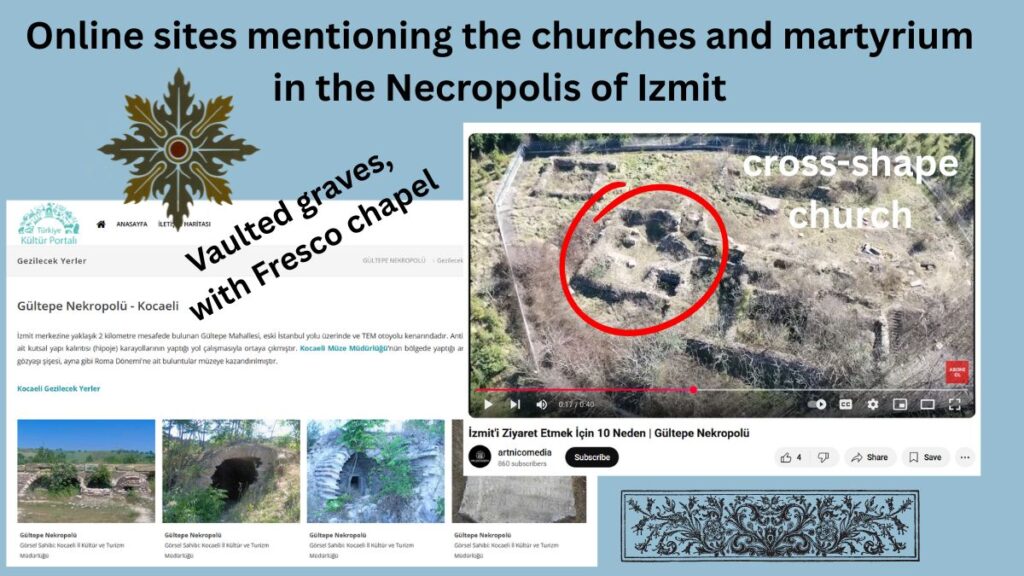
Orhan Cami (Hagia Sophia of Nicomedia)
Orhan Camii (named after Sultan Orhan Gazi who ruled from 1324 to 1362) stands on a terrace above the old city center, in a commanding position. This is the elevated and central spot often chosen for Byzantine churches. Researchers such as Semavi Eyice and Doğan Kuban note that Orhan Camii exhibits signs of reusing spolia (Byzantine columns, capitals, and marble blocks) in its construction. These are thought to have come from a pre-existing Byzantine church structure on the site. The building is Ottoman, but the use of spolia in the walls shows that something existed there before.
Clive Foss suggests that this was the Hagia Sophia church of Nicomedia, as the topography gives the location a commanding position. The historical pattern of the Seljuks and Ottomans often converted important Byzantine sites into their central mosque, which Istanbul, Iznik, Bursa, and Antalya illustrate. We can assume that Nicomedia fell into the same pattern, especially since it was once the capital of the Byzantines. Below is the six Byzantine circles that shows the cross pattern.
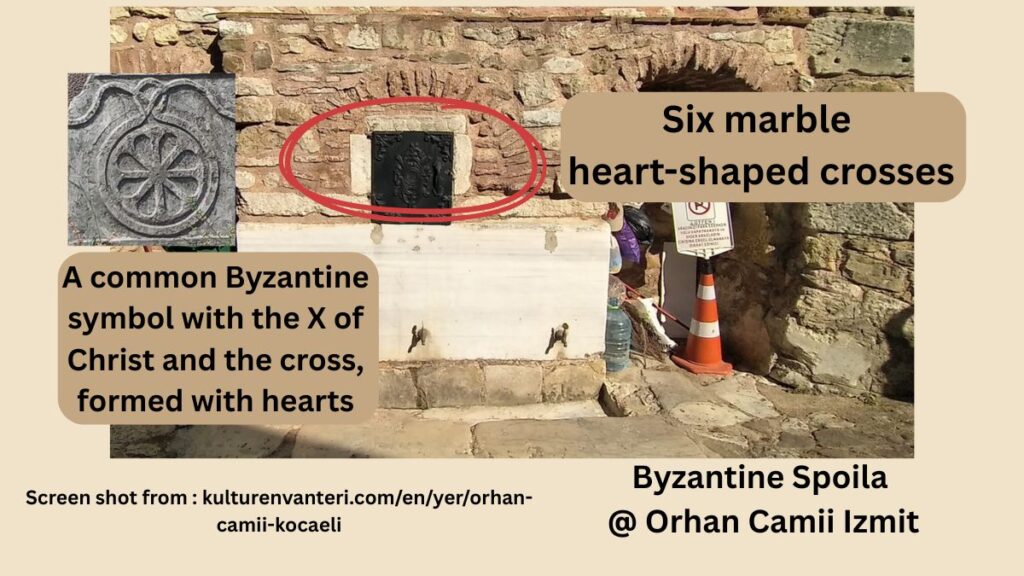
Another item found at this site reflects spolia from the former church. A baptism boat, which is more akin to a limestone laver for sprinkling holy water, was formerly stored in the courtyard. Still, with the recent renovations, this basin is now out of view.[8](https://www.arkeolojikhaber.com/haber-izmit-orhan-camiindeki-vaftiz-teknesi-yok-oldu-8910/ At least two pieces of spolia have been found in the courtyard.[9]The laver is included in this number. https://www.scribd.com/document/902429184/354800, 23
Yeni Cuma former non-Church
Mimar Sinan’s Yeni Cuma (Pertev Mehmet Paşa) Camii in Izmit is a 1579 domed mosque that, in recent times, has claimed to have been built upon the remains of a 12th-century Byzantine church. Unfortunately, there is no proof to this claim and no Byzantine spolia at the site. The original Ottoman Vakif passages[10]Bayezid Umumi 5157 / VGMA Defter 740 say that the ashlar stone and marble of the building were original for this project, with no reference to a former church site. Yet, no archaeological digs have been done on this site, and with its central location, it is most likely part of the city’s civil area before the 16th century.
I believe the mix-up comes from the Travelog site that most likely borrowed information about the Yeni Cuma mosque in Trabzon, but placed this information in the same name place in Izmit. Here is a ChatGPT explanation of the mix-up:
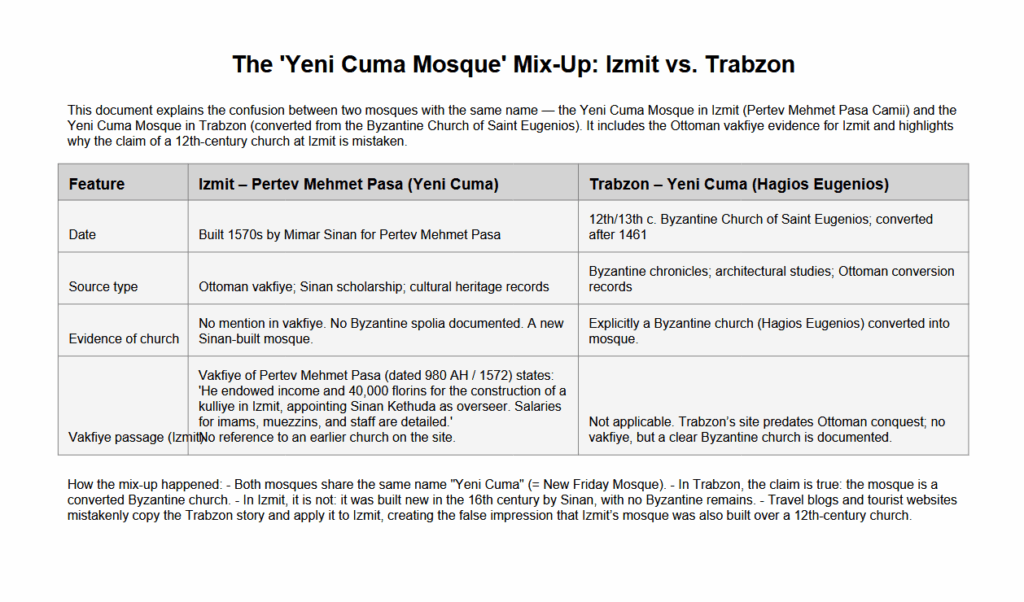
In looking for these ten churches of ancient Nicomedia, one happens not to exist, but we found an additional one with the Northeast Necropolis Basilica. As more evidence comes forward, I will update my findings. In my search, I always appreciate feedback and any new finds that you may come across.
My other searches contrast both religions of Izmit. See my book below.

References
| ↑1 | Life of St. Theophylact, 8 [BHG 2451; VOG, 75] |
|---|---|
| ↑2 | Greek name of the church: Ἅγιοι Ἀνάργυροι — Κοσμᾶς καὶ Δαμιανός“ |
| ↑3 | https://ikee.lib.auth.gr/record/124508/files/GRI-2010-5760.pdf |
| ↑4 | https://www.johnsanidopoulos.com/2019/12/the-prison-of-saint-barbara-in-nicomedia.html?utm_source=chatgpt.com |
| ↑5 | Yenidoğan-Gültepe Nekropolü Arkeolojik Sit Alanı – Kocaeli – İstanbul ıı nolu K.T.V..K.K. nun 05.07.1994 tarih ve 3507 sayılı kararı |
| ↑6 | Turkish original: Bu alandaki Bizans Mezarları İçinde fresko tekniğinderesimlenmiş doğa ve hayvan temalı resimler tespit edilmiştir.Aynı alanda ortaya çıkarılan 11.yy büyük bir kilise ve müştemilatlar ki bunların dini okul ve ve lojman olması muhtemeldir. Aynı alanın doğu kenarında haç planlı küçük bir kilise temelleride ortaya çıkarılmıştır. |
| ↑7 | http://www.kulturvarliklari.gov.tr/sempozyum_pdf/muze_kurtarma/04.muze.kurtarma.pdf, 359 |
| ↑8 | (https://www.arkeolojikhaber.com/haber-izmit-orhan-camiindeki-vaftiz-teknesi-yok-oldu-8910/ |
| ↑9 | The laver is included in this number. https://www.scribd.com/document/902429184/354800, 23 |
| ↑10 | Bayezid Umumi 5157 / VGMA Defter 740 |
[…] Ἀνάργυροι — Κοσμᾶς καὶ Δαμιανός — Agioi Anargyroi (Cosmas & Damian). In my previous write-up, I attest to the church’s presence in […]